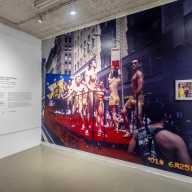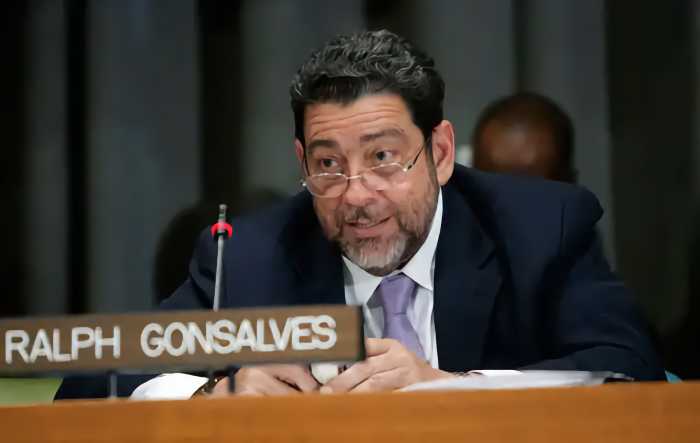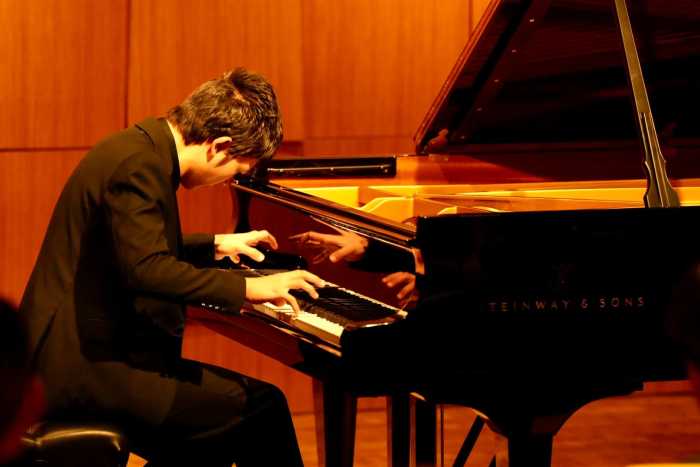It was the giant red star that so intrigued me, a remnant of Cuba’s ties to the Soviet Union. Forty long years ago, that connection nearly brought the world to nuclear war, but now the star is faded and chipped, barely hanging onto this government building.
I was only a block or two from Coppelia, the ice-cream palace made famous by the 1994 gay Cuban movie Strawberry and Chocolate. It was Coppelia that grabbed the attention of most of the tourists on La Rampa, as a sign of what Cuba is becoming. Its reputation as a local gay hangout draws tourists here looking for more to lick than an ice-cream cone.
Tourism and Gay Cuba’s Changing Face
Out of the corner of my eye, I saw several jineteros and pingueros, the men who offer services to tourists, leaning up against the fence surrounding Coppelia. Some tried to catch my attention, but on my first day in Havana, I preferred to walk around the city. This was supposed to be an architecture night.
But then a young man stepped behind me and said, “This is the government information office, but it’s closed now.”
Of course I knew what it was—I could read the sign—but also realized it was probably the easiest thing he could say to start a conversation.
I hadn’t intended on hooking up with anyone that night, but I figured why not let him keep talking so I could see what the city was about. His name was Angel––which made me laugh a little––and he claimed to be a student at the University of Havana in the same department as my hostess, Laubel Pimentel, a professor there, but he had no idea who she was.
In fact, Angel looked more like a tourist himself than a local, light haired and blue eyed. He wore the granola gear of a Vermont vegetarian, a burlapy shirt, loose pants, a Guatemala belt, and Birkenstocks. He was hardly the image I had in mind of a suave Havana lover.
Angel kept trying to hold my hand as we walked along, which worried me, far away as I was from Chelsea.
“Can you do this?” I kept asking. “We’re in Cuba.”
To which he simply answered, “But this is Havana.”
That made some sense to me, though Reinaldo Arenas’ stories about official repression nagged at me from the back of my mind.
We arrived at the decrepit house of an old ballet star who rented a room for people seeking short trysts. His living room was small, dirty, and cramped, but adorned with photos of his days as a star. He was handsome then, but it was hard to see the same face in him now, so many decades of life later. He never told me his name, but Angel said you can look at old pictures of Havana theaters and there he is on many a marquee.
This was all in the 40s and 50s, the man said.
“Before Castro,” I added, as he nodded, petting a small dog he had chained to the chair in which he sat.
When we were done with our business in the man’s house, Angel said he was buying new schoolbooks the next day that were very expensive. Would I be able to help him out? I also needed, he told me, to leave a little something for the old man.
I left feeling more than a little dirty, especially when Angel said he could not be seen exiting the house with a foreigner, that he’d be shaken down by the police. That certainly wasn’t his fear earlier when we strode past policemen while holding hands. Angel said he would look for me the next day at Coppelia. I hoped we wouldn’t see each other again.
Real gay nightlife in the American or European sense doesn’t much exist in Havana. But if you look, you can find gay parties virtually every night of the week. The easiest way to do this is to head to the “Corner” and––no surprise––it’s near Coppelia.
The intersection of La Rampa, or 23rd Street, and L in Vedado is one of Havana’s busiest hangouts, gay or straight. On one corner is the enormous Hotel Habana Libre, formerly the Havana Hilton. Having opened just months before the Revolution, it was one of the first American properties Castro seized when he came to power. Now the building is full of Spanish and Italian tourists looking for the decadent lifestyle that made Cuba famous under Castro’s predecessor, Batista. People drink mojitos in the lobby and shop in the adjacent mall for hip-hop sneakers and imported perfume while starving women in ripped clothes beg for milk for their babies outside.
On another corner is the 1950s Yara Cinema, which was playing Minority Report. Frankly, Tom Cruise was not what I had expected in Havana. In front of the Yara in the evening, you can almost always find dozens of young gay men and women chatting, hanging out, and making plans for the long night ahead in a secret location miles and miles away.
This ain’t your father’s Cold War Cuba, I quickly realized.
One evening I headed to the Corner looking to make some new friends. Fortunately, I instantly fell in with a trio that included Magdelena, who defined herself by saying, “I look like a woman but I think like a man.” She struck me as very daring in her high hair, heels, low halter, and make-up.
The two men with Magdelena were her butch foils––Reinaldo, whose eyes were constantly scanning each new tourist, and his slightly older and very handsome uncle, Fernando. They were fascinated by the fact that I was a journalist writing about gay life, but I wasn’t their first. Only a few months earlier, a writer from Madrid had spoken with Fernando. Later, Fernando would proudly show me the Zero magazine article he helped the Spaniard with.
It wasn’t just young gay men and the tourists who loved them on the Corner though. There were several policemen who played a game, shooing us away when the crowd became too thick. Sometimes that game results in some of the locals spending a night in jail.
But Magdelana mostly ignored the police, and held my arm as she introduced me to other friends. Many were handsome but slightly rough men in their early 20s. A few seemed on the make, eager to meet tourists as I had been told would be the case. Still, others were just crazy club kids, wearing J-Lo sunglasses and tight shiny outfits, the same as guys their age at the Roxy back home.
Special taxis lined up around the Corner, and the drivers all knew the secret location of the evening’s gay parties. Getting into a cab was not a simple matter though. My new friends spoke with the drivers, but avoided the glare of the police as they did so, and when it came time to hire a cab, we made a mad dash away from the police to another street. The police in pursuit began whistling and waving to stop us from getting in a cab.
“It’s like a joke” explained Magdelana, when I asked her about the police once we were safely on our way. “At times it’s too much, but I think, honey, we have the real power.”
But later, stopped at a roadblock in the middle of nowhere, just shy of the party, the police forced the driver to get out, show his ID, and answer questions for several minutes. Even as Fernando kept his arm around my shoulder, making me nervous once again, the police were signaling that they had the upper hand. They obviously knew where the “secret” party was, and we were given access at their discretion.
The party was in a courtyard between some small houses, and in time, hundreds of locals and tourists were dancing to music I could have heard at home––Whitney and Britney, with some Latina divas thrown into the mix. A few men wore U.S. flag bandanas on their head, which Fernando said could get them arrested. I asked Magdelana why people living in the complex didn’t call the cops.
“If I pay you, you say nothing,” she responded.
My friends tried to introduce me to the man who ran the party, but when they told him I was a journalist, he refused to talk to me.
We left at 4 a.m., returning to the Corner to hit the bar La Arcada. Though Fernando said many tourists in Cuba are disappointed when they can’t find the sorts of gay bars they’re used to at home, this place comes close. The odd thing is that it’s owned by the government.
Gays used to hit a bar called Fiat on the heavily traveled Malecon nearby, but its visibility was proof that homosexuality existed in Cuba, so something had to be done. As long as gays stay inside the cramped, smoke-filled Arcada on a dark side street, the police are happy. When I asked the waitress about all the gays in a government-owned bar, she responded, “They come in, they buy drinks, what’s the problem?”
Each night I returned to the Corner, I would see the same thing. The police would periodically clear the streets, hauling unfortunate young men away for the night. Officially, they were never taken away because they were gay, but rather because they did not have their ID cards with them. Fernando said many of his friends had spent a night in jail.
But every gay person I met assured me that life improved in Cuba after the release of Strawberry and Chocolate. I wondered how bad it must have been before and also how the movie ever got made. Then again, the movie sure serves as great publicity for Castro in the rest of the world.
Yet, in spite of the terrible harassment I saw, I also encountered other contradictory signs throughout Cuba. When meeting me, many Cubans in fact would mention Strawberry and Chocolate, seeming to invite me to come out to them. For ordinary Cubans, even in some of the smaller towns, it seemed to be a non-issue.
I even found the contradictions at institutions run by the government. The explicitly homoerotic art in the Fine Arts Museum was unexpected. A drawing by Luis Peñaluer on the second floor shows two men having sex while a woman jumps over them. The mood is very Basic Instinct and a knife lies under them. A painting of a Cuba versus the U.S. boxing match depicts the American down on the ground, his head just at the crotch of the Cuban, as if performing oral sex. There’s also a multi-media work by a group of artists called Los Carpinteros with peek–a–boo openings showing wood carvers casually working in the nude, their penises just inches from each other’s mouths.
I asked the employees whether there had ever been controversy over such exhibitions and they said the idea that works of art would be repressed was unthinkable. Bringing culture to the masses was one of Castro’s premiere desires, they said, a cornerstone of the Revolution. Indeed, in a temporary exhibit I saw in Old Havana, one of the largest pieces showed the island of Cuba with a giant wall around it. In the waters between Cuba and Florida, there were dozens of people in tubes and rafts avoiding sharks. It was clearly a stab at Castro, but there it was.
Officially, tourism is used to further the aims of the Revolution, that nearly crumbled with the collapse of the Soviet Union. My hostess Laubel told me of the terrible times the country suffered in the early 1990s, which are well documented in exhibits at the Museum of the Revolution at the former Presidential Palace. Opening the country to tourism was a way to bring in hard currency for healthcare initiatives and educational programs, two of Castro’s bona fide achievements.
To the tourist with an open mind, many examples of the social benefits of this approach are evident throughout Habana Vieja, the city’s colonial core. Tourist taxes are used to build low income housing throughout the area, as well as to provide funding for a maternity clinic. Contrast this with redevelopment of Puerto Rico’s Old San Juan, where revitalization forced out the poor.
“[The poor] have the right to live in that part of the city,” according to Rafael Rojas, director of the Master Plan for Old Havana. “I believe that the social ideas will remain, to change things for the better.”
Rojas argued that limited capitalism can go hand in hand with socialism, and discussed the Benetton on San Francisco Plaza as a good use of a capitalist store to pay for the cost of preserving a building. Someday, he said, Gaps will be all over former shopping areas like Paseo del Prado, transforming them into thriving hubs like Miami Beach’s Lincoln Road. But the poor will remain in the apartments above, their living situations vastly improved by this influx of money.
Yet tourism has created instability at odds with socialist values. Luis, a guide for one of my tours, explained that his family had all been doctors. But now, with prostitutes able to make in ten minutes what it took his father a month to earn, the profession no longer garners the respect it once did.
Doctors and professors, often with larger than average homes, have opened up casas particulares, private apartments for tourists. This helps them so much financially, it’s hard to see them continuing to dedicate time to their fields. How many students and patients will suffer then, damaging the Revolution’s two most important achievements?
In some ways, society under tourism is beginning to replicate the problems of Batista, when foreigners ruled the country. Except, it’s not sugar that’s for sale anymore, it’s the people themselves. To see examples of two worlds co-existing, however awkwardly, stand outside of the restaurant El Conejito in Vedado. This fancy restaurant is across from a row of half-collapsed slum dwellings. The residents sit on their porches looking longingly at the rich crowds of tourists waiting to get inside.
Or head to El Floridita in the city center, an expensive restaurant made popular by the mystique of Hemingway’s time in Cuba. You’ll see several women with push-up bras and tight skirts pressed against the glass, hoping a tourist invites them inside.
Many say that coming to Cuba only helps Castro maintain his power, that touring this country supports totalitarianism. I am not sure that I agree with that assessment. As American and European music and movies are rapidly introduced into the country, the locals are being exposed to new ideas. I felt privileged, as an American journalist allowed to travel to Cuba legally, to witness the country and speak with its people directly, unfiltered by our media and the opinions of exiles in Miami.
As a gay man and a writer, I believe that new ideas can change Cuba. Fernando had never heard of the rainbow as a gay symbol. When I gave him a rainbow necklace and told him that hundreds of thousands of gays and lesbians take to the streets in New York every June, many wearing things like this, it was completely unfathomable to him. I also gave him an HX and a Next to take a look through. He is a 32-year-old man, yet his eyes widened like a child’s as he looked at the photos inside.
How long can a regime last when the dreams of its people are unleashed this way?
Getting There
It was legal for me to visit Cuba as a journalist, but there are other legal entrees as well. Cuban-Americans may visit family each year, and doctors, writers, artists, and various other professionals also may obtain travel licenses under certain circumstances. Visit www.ustreas.gov/ offices/enforcement/ofac/speeches/traveltocuba.html for further details and a list of authorized travel agents.
It’s also possible to go to Cuba on guided educational programs. The Center for Cuban Studies arranges trips with various themes throughout the year can be contacted at 212.242.0559 or www.cubaupdate.org. The Center has a large research library, so it’s worth a visit before your trip.
For gay specialized educational tours of Cuba, I recommend Coda Tours. They run several every year, and their itinerary includes Havana and other cities. Contact them at 212.741.5040 or www.coda-tours.com.
































